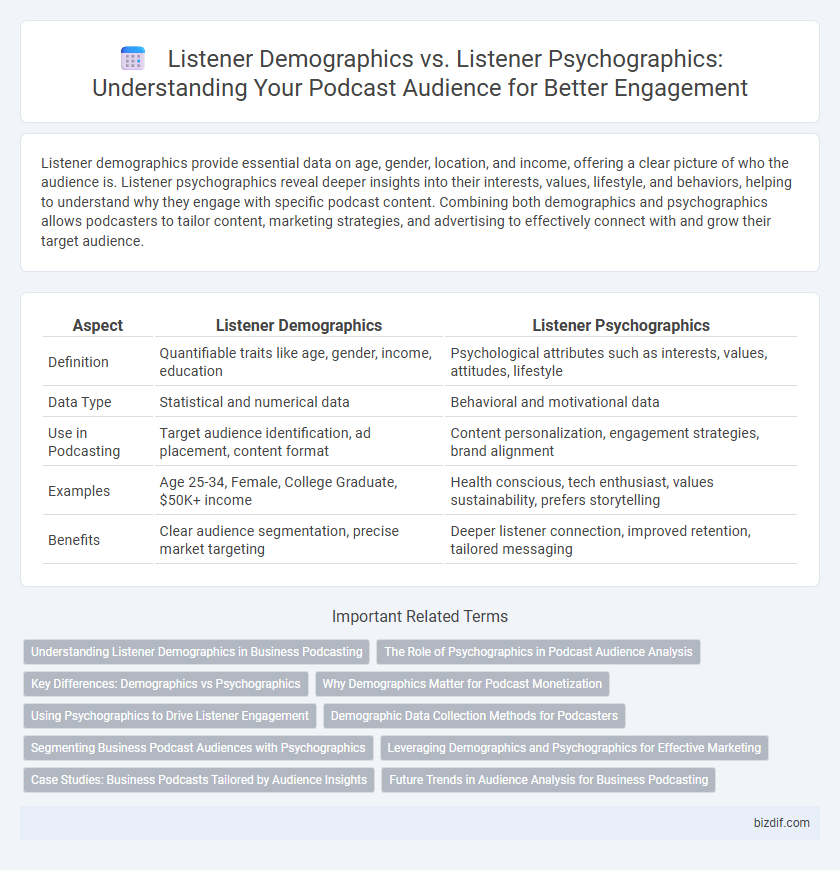Listener demographics provide essential data on age, gender, location, and income, offering a clear picture of who the audience is. Listener psychographics reveal deeper insights into their interests, values, lifestyle, and behaviors, helping to understand why they engage with specific podcast content. Combining both demographics and psychographics allows podcasters to tailor content, marketing strategies, and advertising to effectively connect with and grow their target audience.
Table of Comparison
| Aspect | Listener Demographics | Listener Psychographics |
|---|---|---|
| Definition | Quantifiable traits like age, gender, income, education | Psychological attributes such as interests, values, attitudes, lifestyle |
| Data Type | Statistical and numerical data | Behavioral and motivational data |
| Use in Podcasting | Target audience identification, ad placement, content format | Content personalization, engagement strategies, brand alignment |
| Examples | Age 25-34, Female, College Graduate, $50K+ income | Health conscious, tech enthusiast, values sustainability, prefers storytelling |
| Benefits | Clear audience segmentation, precise market targeting | Deeper listener connection, improved retention, tailored messaging |
Understanding Listener Demographics in Business Podcasting
Listener demographics in business podcasting include quantifiable data such as age, gender, income, education level, and geographic location, providing essential insights for targeted content and advertising strategies. Understanding these demographic factors helps podcasters tailor episodes to the specific preferences and needs of their audience, enhancing engagement and sponsorship opportunities. Accurate demographic analysis drives effective marketing decisions by aligning podcast content with the characteristics of the most relevant business listeners.
The Role of Psychographics in Podcast Audience Analysis
Listener psychographics provide deeper insights into podcast audiences by analyzing values, interests, lifestyles, and attitudes, which go beyond basic demographic data like age, gender, and location. Understanding psychographic profiles enables podcasters to tailor content, marketing strategies, and advertising to resonate emotionally and cognitively with their audience. This nuanced approach enhances engagement, loyalty, and monetization potential by aligning podcast themes with the audience's intrinsic motivations and preferences.
Key Differences: Demographics vs Psychographics
Listener demographics focus on quantifiable attributes such as age, gender, location, and income level, providing a statistical overview of the podcast audience. Listener psychographics delve into psychological traits including interests, values, attitudes, and lifestyle choices, offering deeper insight into audience motivations and preferences. Understanding the key differences between demographics and psychographics enables podcasters to tailor content and marketing strategies more effectively to engage and retain their target listeners.
Why Demographics Matter for Podcast Monetization
Listener demographics such as age, gender, location, and income directly influence podcast monetization by helping advertisers target specific consumer segments, increasing ad relevance and conversion rates. Understanding demographics allows podcasters to tailor content and sponsorship deals to audience profiles that align with advertiser goals, maximizing revenue potential. Data-driven insights into demographic trends enable precise market positioning and enhance the effectiveness of programmatic ad placements.
Using Psychographics to Drive Listener Engagement
Listener psychographics, including values, interests, and lifestyle choices, provide deeper insights than traditional demographics like age or gender, enabling podcasters to tailor content that resonates emotionally. Targeting psychographic profiles increases engagement by fostering a stronger connection between the podcast and its audience's motivations and preferences. Leveraging psychographic data for personalization enhances listener loyalty and drives sustained growth in podcast consumption.
Demographic Data Collection Methods for Podcasters
Podcasters collect demographic data through surveys, social media analytics, and third-party platforms like Spotify for Podcasters and Apple Podcasts Connect, which provide age, gender, location, and device usage metrics. Understanding listener demographics, such as income level, education, and occupation, helps creators tailor content and advertising strategies effectively. Integrating demographic data with psychographic insights like interests and values offers a comprehensive audience profile for targeted podcast marketing.
Segmenting Business Podcast Audiences with Psychographics
Segmenting business podcast audiences with psychographics offers deeper insights into listener behaviors, values, and motivations beyond basic demographics like age and gender. By analyzing attitudes, interests, and lifestyle choices, podcasters can tailor content to resonate with specific audience mindsets, leading to higher engagement and loyalty. This approach enhances audience targeting precision, driving more effective marketing strategies and sponsor alignment within the business podcasting landscape.
Leveraging Demographics and Psychographics for Effective Marketing
Listener demographics provide essential data such as age, gender, income, and location, offering a foundational understanding of the podcast's audience composition. Psychographics reveal deeper insights into listeners' values, attitudes, interests, and lifestyle choices, enabling highly targeted and emotionally resonant marketing campaigns. Leveraging both demographics and psychographics allows marketers to craft personalized content and advertisements that increase engagement, loyalty, and conversion rates in podcast marketing strategies.
Case Studies: Business Podcasts Tailored by Audience Insights
Business podcasts leveraging listener demographics such as age, location, and occupation yield essential baseline data for targeted content creation. However, integrating listener psychographics--attitudes, interests, and values--enables deeper personalization, resulting in higher engagement and conversion rates. Case studies reveal that podcasts tailoring episodes based on comprehensive audience insights achieve stronger brand loyalty and more effective advertiser alignment.
Future Trends in Audience Analysis for Business Podcasting
Listener demographics in business podcasting traditionally focus on age, gender, location, and income, while listener psychographics delve into values, interests, and lifestyle preferences, offering deeper audience insights. Future trends in audience analysis emphasize integrating AI-driven sentiment analysis and behavioral data to create highly personalized content strategies that resonate on a psychological level. Enhanced psychographic profiling enables marketers to anticipate listener needs, drive engagement, and optimize ROI through targeted advertising and refined content development.
Listener Demographics vs Listener Psychographics Infographic

 bizdif.com
bizdif.com